Web design has improved by leaps and bounds within the past 10 years. Yet there is still a substantial amount of poor UX design today, even with more UX professionals on the job. Why? High organizational politics and immaturity, lack of UX skill or training, and development processes which ignore UX are just some of the reasons. We have known this for many years. But what we didn’t know is how effective UX people feel they are at their jobs, and why.
Survey of UX Professionals
To understand the current state of UX, we asked 360 UX professionals about how effective UX was and how powerful a voice it had at their organizations. The participants answered an online questionnaire about their perceptions of UX effectiveness and design quality, and about management and organizational structure at their companies.
Respondents: Job Titles and Organization Sizes
While people wear many hats in the UX arena, we asked respondents to choose the one role that they most identify with for the purposes of this survey. About 52% of respondents chose a UX-related title (UX designer, UX researcher, UX manager, or UX consultant). Another 7% had roles closely associated with UX (information architect, visual/graphic designer, customer-experience specialist). A large portion of our respondents (17%) felt that none of our titles represented what they did. This broad distribution is in line with our study of UX careers, which found a wide diversity in backgrounds and job roles.
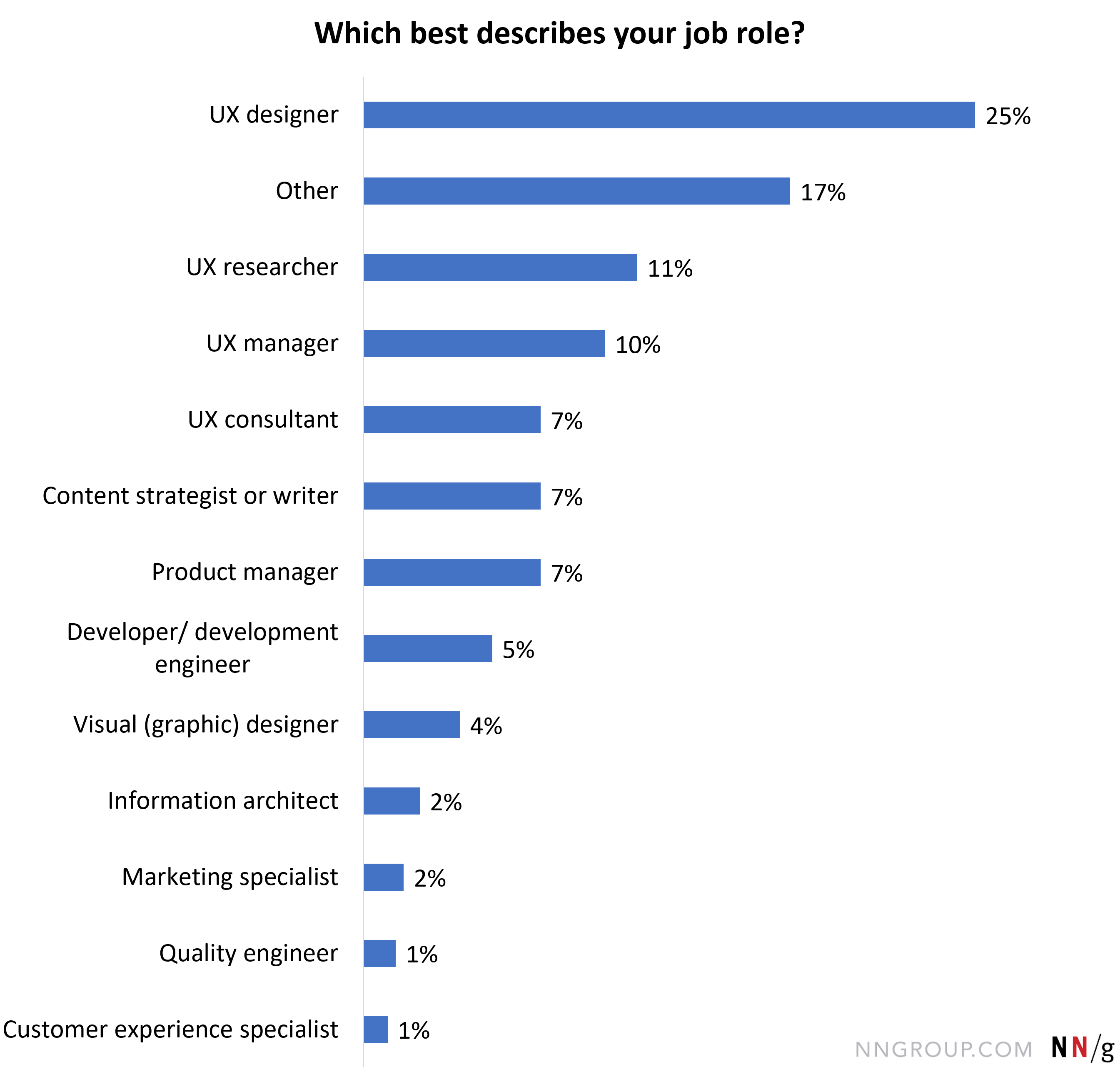
Our survey respondents were uniformly distributed across organization sizes — with one quarter of them working in each of these four organization types:
- More than 10,000 employees (22%)
- 1001–10,000 employees (26%)
- 101–1,000 employees (27%)
- Fewer than 100 employees (25%)
Results
UX Management, Leadership, and Focus on Research: Biggest Challenges for UX Teams
We asked UX professionals to list the biggest problems their teams face today (“What is the biggest problem, or few biggest problems, your UX team faces today?”). We then sifted through their open-ended responses to the question, and categorized and counted how many times each issue was expressed.
While responses ranged from UX immaturity to inability to conduct research, the most common challenge (which accounted for 16% of the total issues listed) surrounded UX management —including lack of UX leadership or UX processes, and UX not having a strong and sustainable position at the organization. 12% of the issues described missing support from the business. And another 10% of the issues cited problems with development processes accommodating UX work.
A complex challenge that accounted for 11% of the reported issues was the organization’s UX maturity. Related to that, weak influence and low visibility or recognition for UX accounted for 8% of the issues. Respondents said that organizations don’t understand the role of UX and how user research can effectively inform design.
Lack of resources to do UX research accounted for 12% of the issues. UX people expressed a great desire to do more research, and frustration with the inability to do so. Listed difficulties included schedule, money, skills, or accessing users.
10% of the issues mentioned lack of UX training and UX experience.
Only 5% of issues were related to actual design challenges. (Remember that we asked about the biggest problems faced by UX teams. Certainly, there are plenty of design challenges, but most of them have a smaller impact that the high-level issues that got most votes from our respondents.)
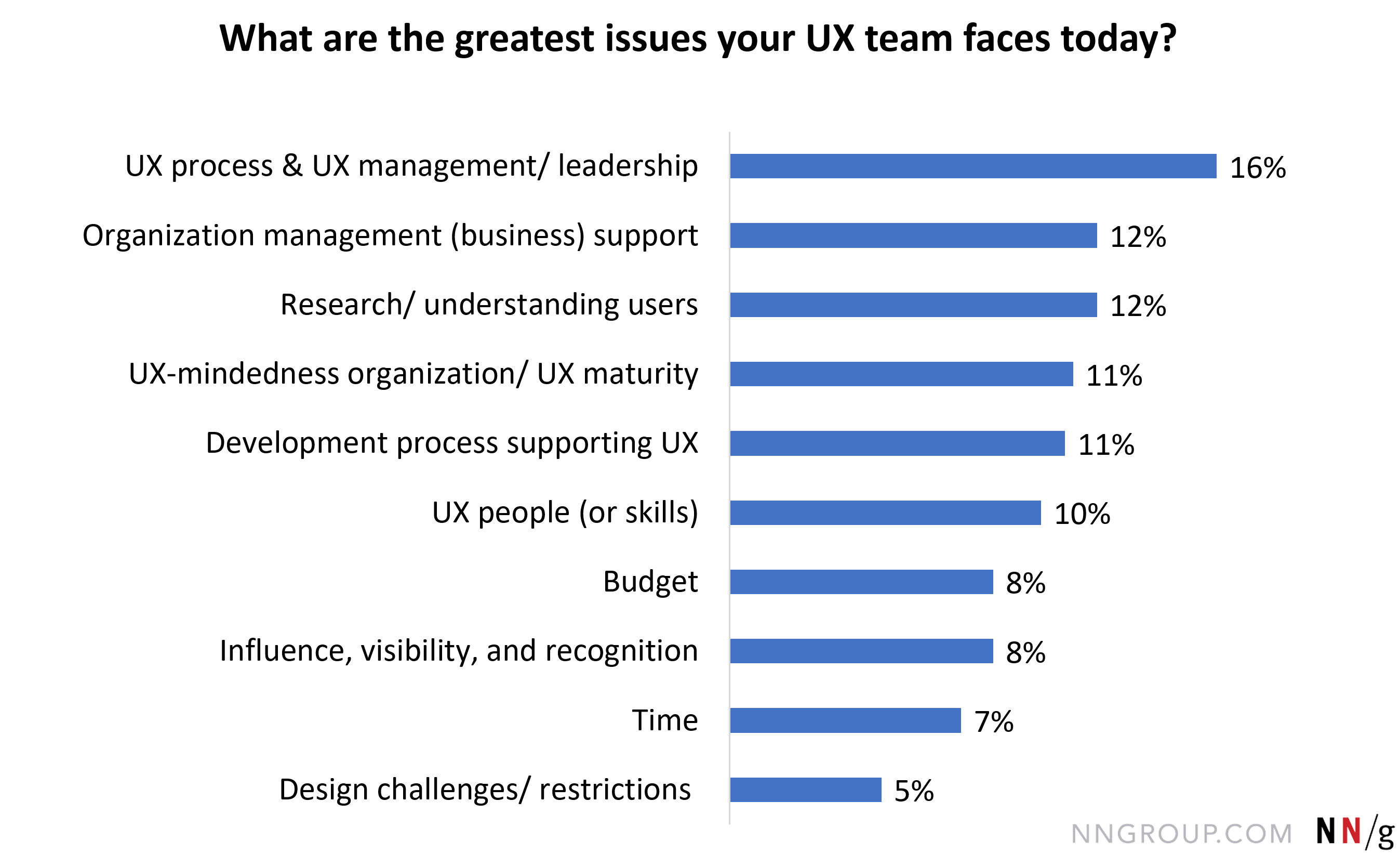
Management Support for UX Is Lacking
Management support for UX is less than it should be. We asked, “In your opinion, how much support, (such as budget, headcount, tools, positive reinforcement) does management give the UX team?” Respondents had to indicate whether the UX team received more, less, or about the same support as other teams.
41% of respondents said that their UX teams got less support than other teams. Better news, 41% said UX got about the same support, and 11% said their UX teams got more support.
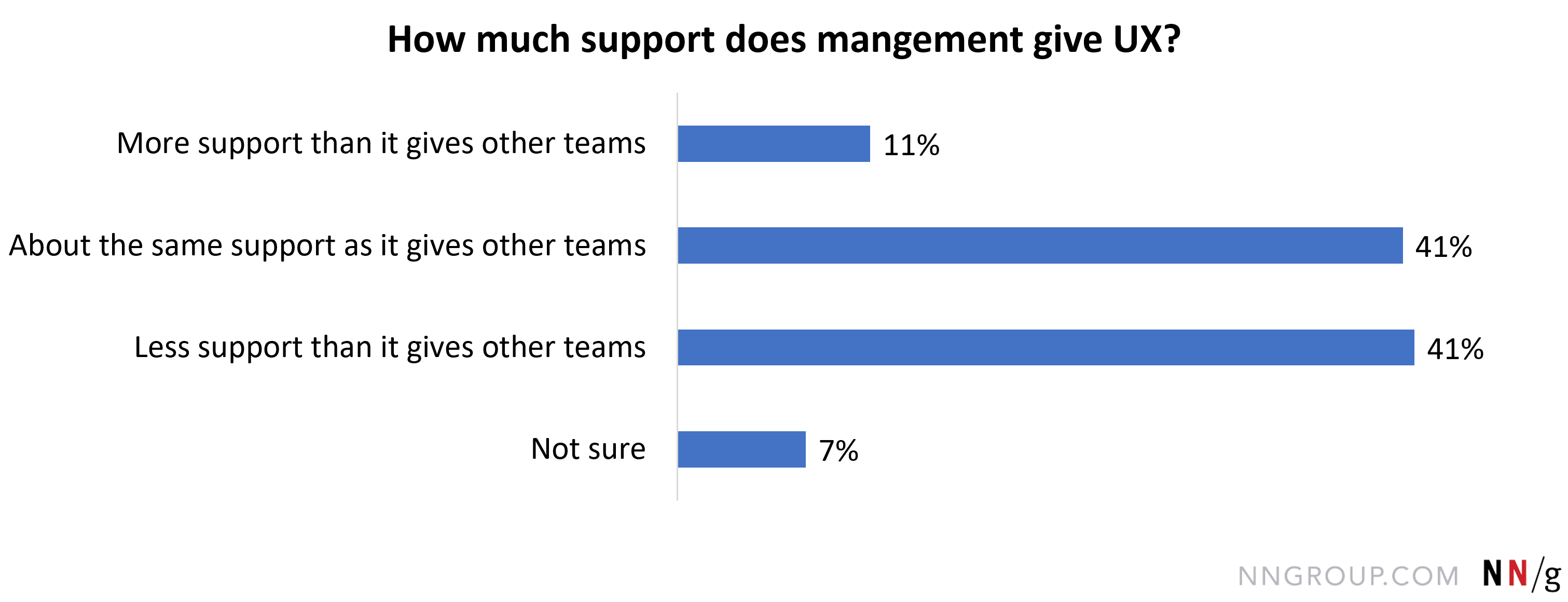
Lacking Executive-Level UX Jobs
We asked survey participants what the highest UX job title was at their organization. Interestingly, 23% of the respondents answered that they are not sure. This does not say much for the visibility of high-level UX leadership.
Most companies wouldn’t dream of existing without a chief financial officer, chief technology officer, or a vice president of marketing. Yet only about 10% our respondents work for organizations with executive UX roles.
“UX director” and “UX manager” were cited as the highest UX job in about 18% of cases. “UX designer” (which is not a management position per se) was the highest UX job in almost as many (about 17% of cases). “UX lead”, a job title which has become popular in recent years, was the highest role in almost 15% of cases.
UX folks were rarely the company’s CEO, and almost as rarely did respondents report the presence of a “chief UX officer”. “UX vice presidents” are only slightly more common.
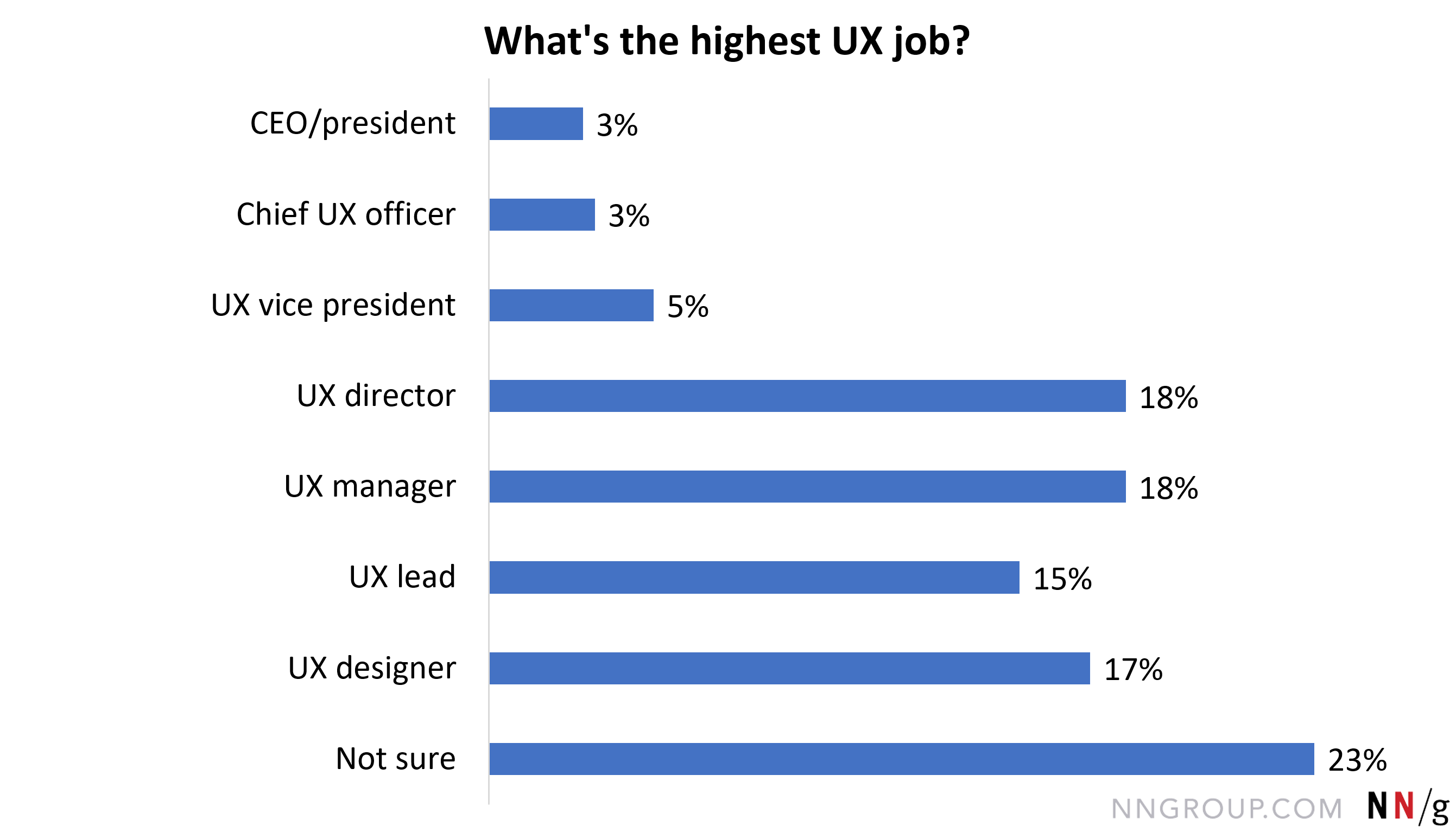
Research Funding
Getting funding to conduct user research has long been a barrier for UX people. We asked our study participants who pays for UX research in their organization. Most (38%) said that the UX team paid for user research. So, research may have been part of the UX budget, or the UX researchers just scraped by, doing very few user studies.
In almost as many cases (31%), the product teams paid for UX research. There are 2 models that support this situation. In one such scenario, UX is simply part of the product team, and research is part of the planning and budget. Alternatively, UX is a central group that caters to and invoices different product teams. This second model can be tricky if the UX group needs to convince product teams to commission its research services.
When consulting firms advertise themselves as design agencies and user research is offered as an add-on, extra-cost service, it can be difficult to sell it to clients. Still, 73% of the respondents who identified themselves as consultants said that when they did UX research, clients paid for it. In the other cases the consultancy absorbed the cost of user research. Agencies that are successful in this area outline research as part of the design process and embed the costs in the total project price.

UX Rarely Reports to a UX Team
A support system for UX is crucial. When our survey respondents were asked to whom they report, 30% said that they reported to a UX or UX design team. Presumably, these professionals have peers with UX experience.
However, the large majority (70%) of the UX professionals did not work in a UX team and reported to a broad range of other non UX functions. This occurs for many reasons. In some cases, UX is viewed as important enough to hire a person or a few people, but not important enough to be a separate department. Or, companies may just stick UX professionals under an existing organizational hierarchy because they are not sure where UX people belong.
Who do these professionals report to, if not to UX roles? After a bona fide UX team, the next most common responses to this question were product management (11%) and product teams (11%). More and more people in product management (PM) take on design and research tasks. If those doing design have the skills and support, and can separate the UX goals from PM goals, then power on! But know that there are inherent differences in UX and PM, not the least of which being that UX is rooted in cognitive psychology and design principles, where PM leans closer to marketing foundations.
On the positive site, reporting to the product team means that UX people are present when decisions are made, and they know the product as well as anyone else on the team. They also forge relationships with engineers and others with whom they need to work well. These things don’t always happen when UX is a centralized group in the organization, and the UX people serve more as consultants who join and leave product teams at critical times.
The biggest downside is that, when UX reports to the product team, it may not be able to negotiate with management about UX design decisions. Also, UX professionals will not be supported formally by organization-level tools, role models, and processes. They may not even have (or know of) UX counterparts working on other product teams.

UX Is Somewhat Effective and Produces Mediocre Designs
When asked how effective the UX team is at their organizations, the predominant answer (57% of respondents) was somewhat effective. More people felt UX was very effective (20%) than ineffective (16%), which is good but not great news.
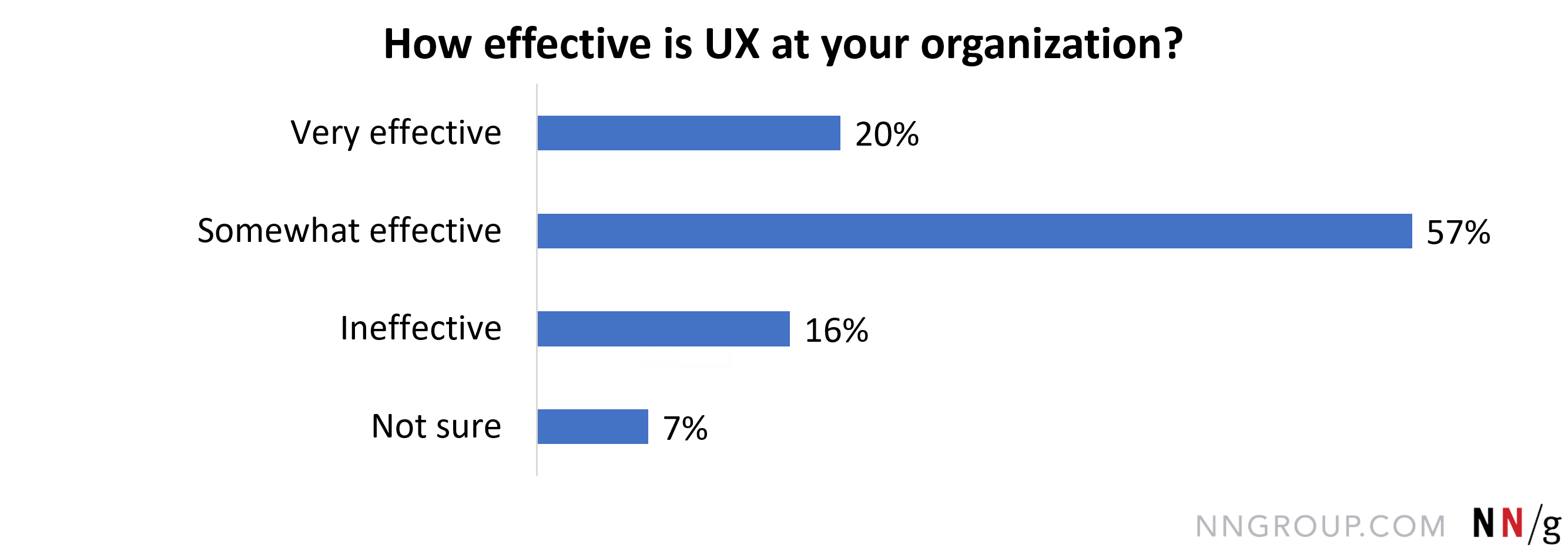
Considering that a “not sure” response is unlikely to include organizations where UX is highly effective, we can conclude that 80% of organizations are below the goal of highly effective UX.
In that same vein, most respondents felt their designs were just somewhat good:
- 56%, somewhat easy to use,
- 51%, somewhat innovative,
- 62%, somewhat aesthetically pleasing, and
- 58% somewhat liked by target users.
Except for the question about innovation, these percentages may not seem that bad. But remember that a truly great product (and a truly effective UX organization) delivers on all 4 quality parameters. Only 7 of the 305 respondents (2%) said that their designs are simultaneously easy to use, very innovative, very aesthetically pleasing, and liked very much by the users. While we may not like this finding, it’s probably realistic: while there are many decent products in the world, great ones are rare.
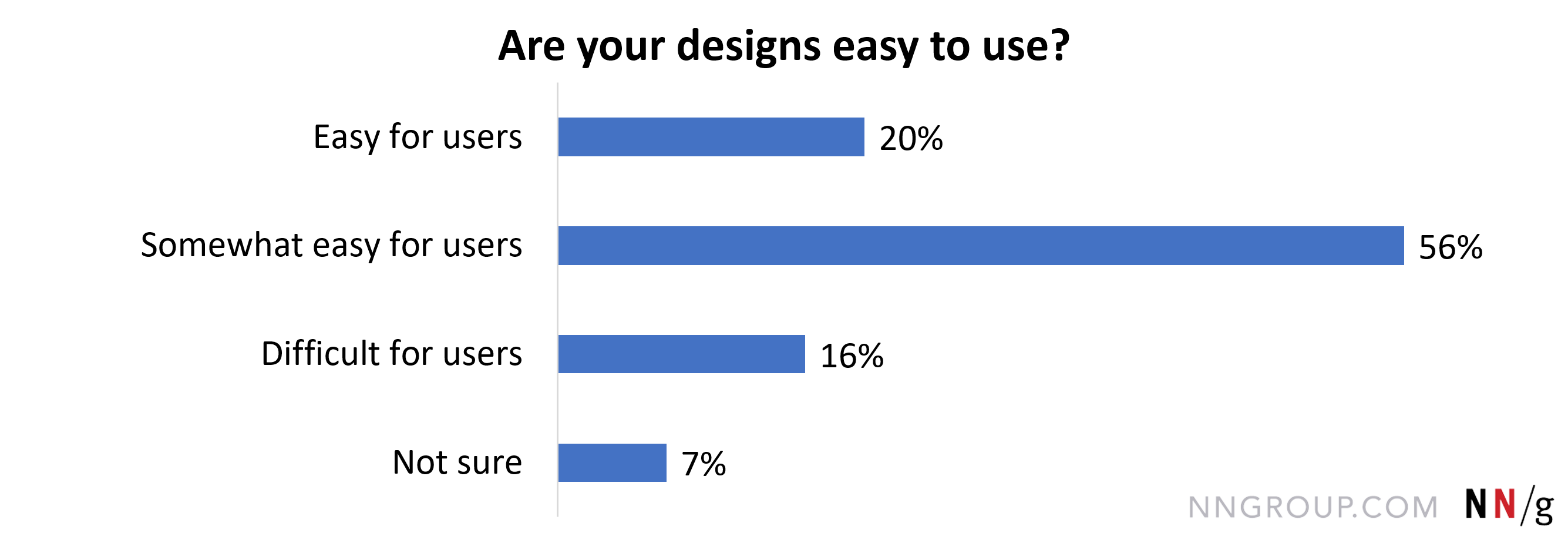
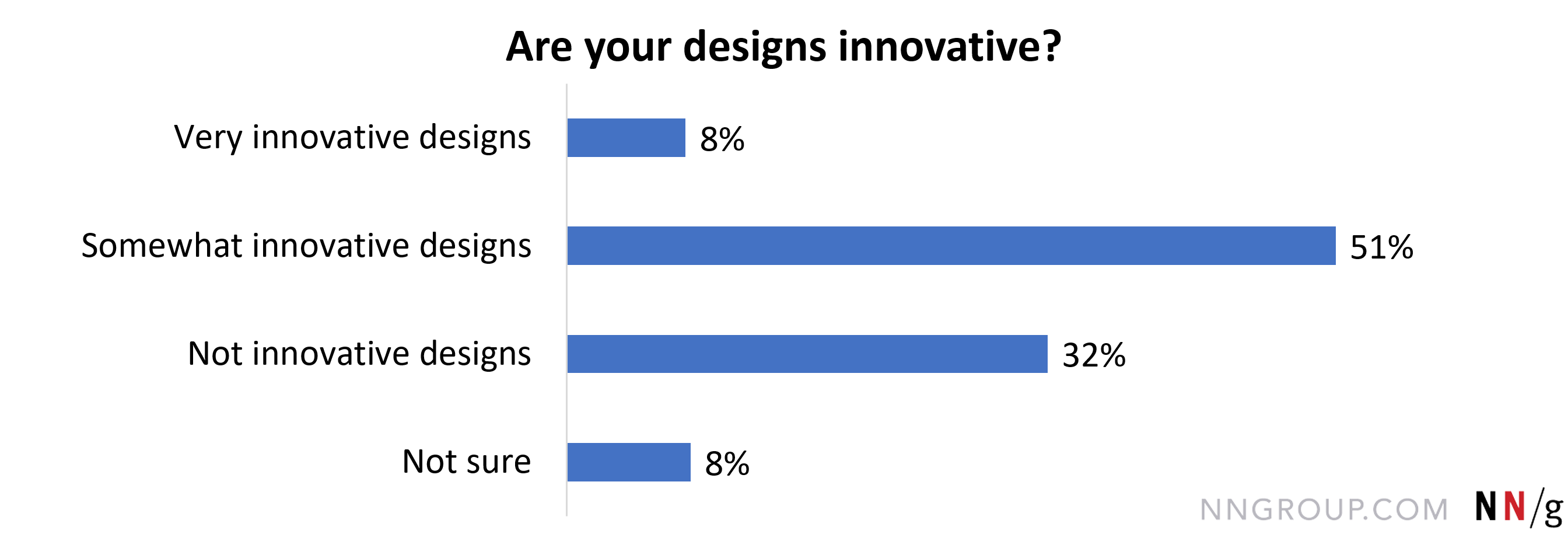
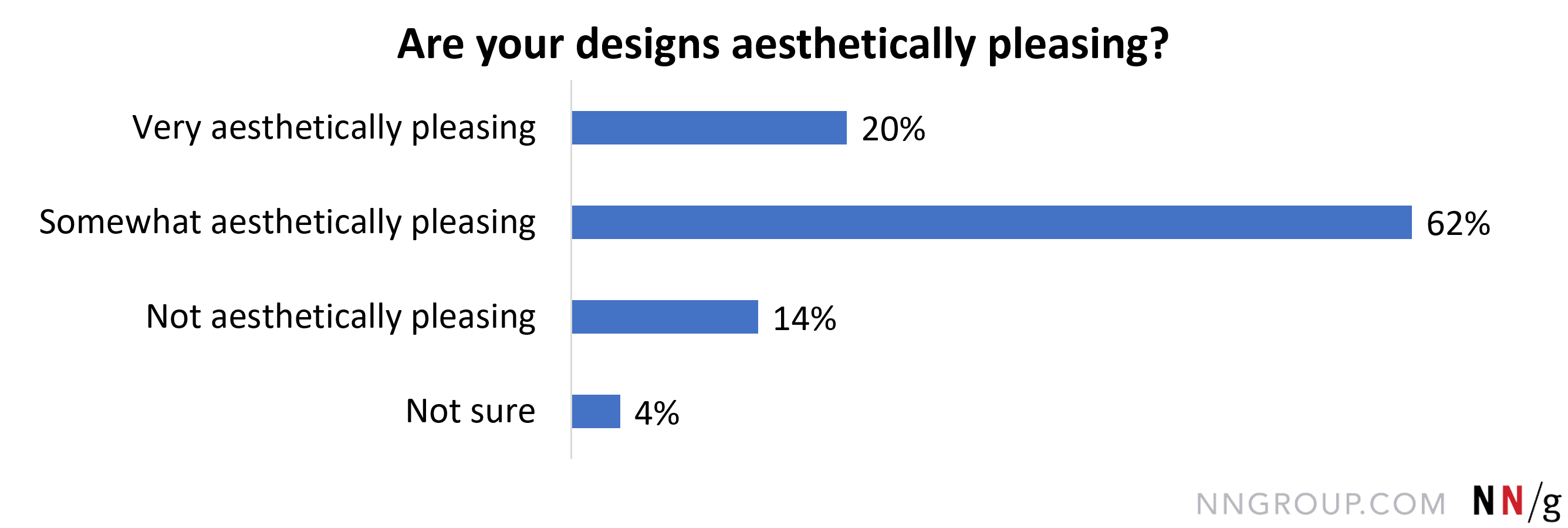
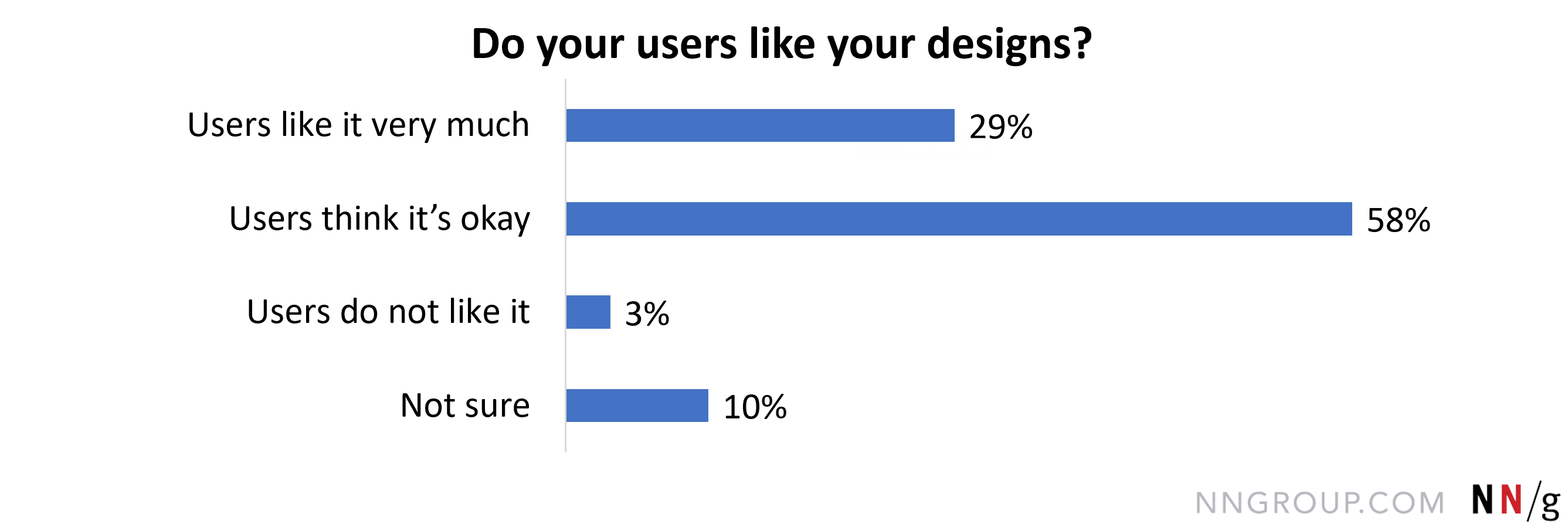
Correlations
We ran some correlation statistics to test our assumptions about the relationship between variables.
Highest UX Job and Funding not Correlated with Perception of UX Effectiveness
Respondents’ perception of UX effectiveness was not correlated with their answers to any of the following questions:
- highest UX job in the organization
- funding that the UX team gets compared to that of other teams
In other words, there was no association between reported UX effectiveness and whether the respondents’ UX team had more (or less) funding than other teams. Moreover, reported UX effectiveness was not related to the respondents’ organization having a high-level UX job such as UX chief officer.
This is good news, especially for smaller companies that cannot afford lavish UX funding or a hierarchy with enough levels for fancy titles.
Reporting to a UX Team, and Being at a Smaller Company Are Correlated with Perception of Higher UX Effectiveness
There were small, but statistically significant correlations between the perception of UX effectiveness and:
- company size (r=0.18), with smaller companies being associated with a higher perception of UX effectiveness
- which department the UX people reported to (r=0.19), with reporting to UX teams being associated with a higher perception of UX effectiveness
The correlation between the perception of UX effectiveness and organization size is somewhat surprising — you’d expect larger organizations to be more effective at implementing UX principles. However, it’s possible that other factors (bureaucracy, politics, inflexible processes) affect the perception of UX effectiveness in these big companies; in contrast, in small, closely tight companies, UX professionals may feel that their voice is heard and they have a bigger say, which can change their appraisal of UX effectiveness.
The second correlation (between the perception of UX effectiveness and which department people report to) is less surprising: Reporting to a UX team may cause UX professionals to feel more confident, understood, important, and thus, more effective. Having a UX team and associated processes likely enables more learning, collaboration, UX-project post-mortem discussions, and tracking of UX improvement data — each of which could help UX people feel effective.
Management Support and UX Effectiveness Are Related
UX professionals who responded that UX was effective at their organizations also said that management demonstrates belief in the importance of UX work. There was a moderate, statistically significant correlation (r=0.48) between how effective the UX team was perceived by the respondents and how much support they felt it received from management.
Effective UX Teams Associated with Better Designs
Respondents who felt their teams were effective rated their designs better. In other words, we found positive, statistically significant correlations between UX effectiveness and how the respondents assessed their designs on the following dimensions:
- usable (r=0.32)
- innovative (r=.36)
- aesthetically pleasing (r=0.37)
And there was a small, statistically significant correlation (r=0.28) between the respondents’ perception of UX effectiveness and how much they felt that users liked their products.
Conclusions
Our survey shows that UX professionals today struggle with poor management support for UX and lack of UX processes and leadership, and they usually don’t have a UX team to support them. A majority perceive UX as being only moderately effective and their companies’ designs as only of moderate quality. Most feel they don’t have the resources to conduct the user research needed to be most effective.
Grow UX Leadership and Fix Processes
How do UX people (or those working in any function) become managers? As much as the world knows about management as a discipline, it is still regular business practice to promote to manager those individuals who are good at the job and not necessarily good at management. UX managers may not all need an MBA, but they do all need management training. And they must think of UX from a project and business perspective. To be effective, UX managers must trade pushing pixels for pushing the UX and business agendas.
Represent UX at the Executive Level
It’s no wonder UX has trouble making its way into design requirements and schedules or getting budget and headcount. Until high-level UX people have a seat at the executive table and can put UX in a business context, UX individuals and teams will continue to struggle.
Create UX Job Titles
It is important for UX people to have stability and something to strive for. These can come from:
- communicating job titles,
- providing a UX career path and higher job titles to aspire to,
- demonstrating that UX managers have power,
- letting UX people who want to pursue management in the UX field know there is a path they may follow, and
- having UX role models to learn from.
Consider Job Satisfaction Effects
We didn’t explicitly ask about job satisfaction. But we speculate that it is not incredibly high among UX professionals since 80% of them do not feel that UX is very effective. This finding probably explains why many of my old UX friends have moved to other careers: they were not able to do their job as well as they knew they could.





Share this article: